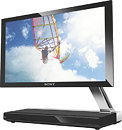qubit
Overclocked quantum bit
- Joined
- Dec 6, 2007
- Messages
- 17,865 (2.78/day)
- Location
- Quantum Well UK
| System Name | Quantumville™ |
|---|---|
| Processor | Intel Core i7-2700K @ 4GHz |
| Motherboard | Asus P8Z68-V PRO/GEN3 |
| Cooling | Noctua NH-D14 |
| Memory | 16GB (2 x 8GB Corsair Vengeance Black DDR3 PC3-12800 C9 1600MHz) |
| Video Card(s) | MSI RTX 2080 SUPER Gaming X Trio |
| Storage | Samsung 850 Pro 256GB | WD Black 4TB | WD Blue 6TB |
| Display(s) | ASUS ROG Strix XG27UQR (4K, 144Hz, G-SYNC compatible) | Asus MG28UQ (4K, 60Hz, FreeSync compatible) |
| Case | Cooler Master HAF 922 |
| Audio Device(s) | Creative Sound Blaster X-Fi Fatal1ty PCIe |
| Power Supply | Corsair AX1600i |
| Mouse | Microsoft Intellimouse Pro - Black Shadow |
| Keyboard | Yes |
| Software | Windows 10 Pro 64-bit |
There has been excitement recently, that the much-anticipated next generation OLED display technology for consumer TVs and computer monitors will finally make an entrance in the market in 2012. Fuelling this, was the announcement last week that LG is to showcase their OLED TV at CES this month. Sony was also due to introduce OLED TVs to consumers. However, this plan has now been shelved, according to The Daily Yomiuri, with Sony only continuing to sell this technology to corporate customers such as broadcasting companies, along with the associated research and development into better displays. The reason for dropping the consumer market is partly due to poor business performance in this area, so Sony cut back on capital investment, which in turn reduced its price competitiveness with its Korean rivals such as LG and Samsung.
This is a shame, because for a healthy and good value OLED TV and monitor market, there need to be many players competing with each other, which will drive down prices and increase product quality over time. However, if OLED takes off in the consumer space, it seems very unlikely that Sony wouldn't return to it eventually.
 Sony XEL-1 OLED TV. Picture credit: engadget
Sony XEL-1 OLED TV. Picture credit: engadget
View at TechPowerUp Main Site
This is a shame, because for a healthy and good value OLED TV and monitor market, there need to be many players competing with each other, which will drive down prices and increase product quality over time. However, if OLED takes off in the consumer space, it seems very unlikely that Sony wouldn't return to it eventually.
 Sony XEL-1 OLED TV. Picture credit: engadget
Sony XEL-1 OLED TV. Picture credit: engadgetView at TechPowerUp Main Site






